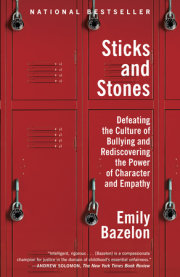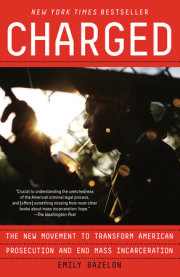Chapter 1
Monique
Monique McClain wanted a new hairstyle for the first week of seventh grade.
She got the idea from her mother, Alycia, who had her long dark hair done up in a sweep over the summer, so that it lay braided smooth on one side of her head and fell in a cascade of curls down the other. Monique, who was thirteen, had her mother’s long dark hair and wanted the sweep for her first week at Woodrow Wilson Middle School in Middletown, Connecticut. She thought it would look grown-up.
A friend of Alycia’s who does hair came over and went to work on Monique. When she was finished and Monique’s hair was sleek and shiny, her mother snapped a photo of her daughter in profile, a stud earring in the shape of an M gleaming below the braids and a shy half smile on her face. She looked like a more glamorous version of her old jeans-and-ponytail self. Monique didn’t usually like to strut, but that morning she let her curls swing on the way to the bus stop. “I was excited to go to school,” she said. “I liked how my hair looked. It felt special.”
But Monique’s head was down when Alycia looked out of her fourth-floor apartment window that afternoon and saw her daughter walking home from the bus stop. Alycia called from the window to ask if the hairstyle had been a hit, and Monique said nothing, just shook her head. At the door she followed her mother’s rules by stopping to take off her sneakers, then came inside to tell what had happened: two eighth-grade girls on her bus, Destiny and Cheyenne, had mocked her for being a “biter”—a copycat. It turned out that Destiny’s cousin had gotten the same hairstyle the week before. Monique hadn’t known that. Still, in Destiny’s and Cheyenne’s eyes, she was a biter, and biters were fair game.
The older girls, who were known for being tough, kept at it the next day. They trailed Monique when she got off the bus, walking a few steps behind her and taunting her all the way down the street and onto the grounds of her apartment complex. Monique didn’t know why they cared so much about a hairstyle. She just wanted it to stop. She went to her room and called her friend Sonia. “The eighth graders are in my face on the bus and I can’t take it,” she said. Sonia didn’t ride Monique’s bus; none of her friends did. She had no one to sit with, no one who could be a buffer against Destiny and Cheyenne.
Listening, Alycia felt bad for Monique, but she figured it would blow over. It was just girls being rude; it was just a hairstyle. They’d forget the whole thing by morning. Wouldn’t they?
But the next afternoon, Monique’s head was hanging again: Destiny and Cheyenne had taunted her for being a biter on the way to school and on the way home. Alycia walked Monique to the bus stop in the morning, stayed to make sure Destiny and Cheyenne didn’t bother her, and at noon headed to Woodrow Wilson to report that her daughter was being bullied. Alycia met with a Middletown police detective who was stationed at the middle school. He called in Monique and assistant principal Diane Niles. Niles told Monique that if the girls made fun of her again on the way home, the school would take action. Principal Charles Marqua came in for a few minutes and also assured Alycia the school would not stand for this kind of behavior. “They said they would handle it,” she told me later. “That they would not tolerate those girls going after Monique like that.”
And so when Alycia met Monique at the bus stop later that afternoon, she expected to hear that the ride had gone smoothly. But Monique was blank-faced and silent. When the other kids streamed away down the street, she mumbled to her mother in a low voice that the eighth graders were now calling her a snitch as well as a biter. No one—not one kid—was sticking up for her. Alycia called the police on her cell phone to make a harassment complaint. She also called Niles, handing the phone to Monique right there on the sidewalk so she could describe how the bus ride had been worse, not better, than the day before.
Niles listened sympathetically and said she would call Destiny’s and Cheyenne’s parents. But later she called Alycia back to say she hadn’t reached the girls’ parents, which meant she couldn’t tell them to stay off the bus. Niles suggested that Alycia drive Monique to school the next day. Alycia, who is a home health aide trained to care for disabled patients, was working the night shift. She asked her mother, Alexa, to drive Monique in the morning. But this didn’t strike Alycia as a viable long-term solution, since Alexa lived a few miles away and Alycia usually borrowed her car to get to work. And why should Monique be the one forced off the bus?
Niles told Destiny and Cheyenne to sit away from Monique on the way home that day and from then on. Over the next several days, the girls didn’t do as they were told. Some afternoons they got off at the same stop as Monique and followed her home, yelling insults along the way. Smoking cigarettes at the bus stop, they blew smoke in Monique’s face.
During the last week in September, principal Charles Marqua boarded the bus in the afternoon before it left school and admonished Destiny and Cheyenne to sit in the back, away from Monique. Marqua was new to the school. He hadn’t had time to establish his authority, and Destiny and Cheyenne decided to test it. Telling Marqua that only her mother could tell her where to sit, Cheyenne turned her back on him and walked down the aisle. Marqua told her to behave and got off the bus. As soon as it left Woodrow Wilson and rounded the corner, the girls moved to seats right behind Monique, cursing her for snitching, and then shadowed her on the walk home from the bus stop. “We don’t totally control the bus,” Marqua would tell me later. “We can only do so much.”
Monique didn’t know what to do or where to turn. Over the weekend, she did her best to shake off the dread she felt about riding the bus. She saw her friend Sonia and a couple of other girls, and tried to make sure that the bullying didn’t infect the rest of her life. “My friends weren’t jumping into it,” she said, talking about the trouble she was having with Destiny and Cheyenne. “I always had a lot of different friends at school. I never had a problem like this before.” In fact, Monique had thrived in school, doing well in math and reading and in fifth grade even winning an academic achievement award. Signed by President Obama, it hung on a wall in her grandmother’s apartment next to the invitation Alexa, a devoted Obama supporter, had gotten to the president’s inauguration.
Alycia and Alexa went back to Woodrow Wilson repeatedly in September to press Niles about why Destiny and Cheyenne had been allowed to keep riding the bus and to keep sitting near Monique. Alycia suggested that the girls be suspended from the bus for a month. Niles finally said she would tell them to stay off the bus. But when they didn’t listen to her and went to the bus stop anyway, it turned out that for liability reasons, the bus drivers had orders to let on any kids waiting at the bus stop. Destiny and Cheyenne kept riding and sitting where they pleased.
At last, at the end of September, the girls got a one-day in-school suspension, which they were supposed to spend in a supervised study hall, isolated from the other students. But in the afternoon, Destiny saw Monique walking by on her way to science class, and from the doorway, hissed, “You think ISS”—in-school suspension—“is gonna stop me?”
Back on the bus, Destiny and Cheyenne tried to provoke a showdown. Instead of sitting apart from Monique as they’d again been told to do, they stood in the aisle, berating her, as a bunch of eighth-grade boys started calling, “Fight, fight, fight!” Monique kept her face turned toward the window, putting every bit of will she had into stopping herself from crying. When the bus driver told them to sit down, Destiny and Cheyenne moved to the back and threw pens and food at Monique, persuading a few other kids to join in.
All of this behavior broke the rules for riding the bus. At the time, though, Connecticut didn’t officially require schools to address bullying on the bus or at a bus stop (the law changed the following year). The administrators at Woodrow Wilson tried to help Monique, but their half measures were no match for Destiny and Cheyenne’s determined meanness. At the end of September, assistant principal Niles returned the bullying complaint form that Alycia had filed weeks earlier, checking off the box saying she’d investigated the case and found that Monique was in fact the target of threats and intimidation. She recommended a mediation meeting between Monique, Destiny, and Cheyenne.
Niles meant well, but sitting all three girls down together was likely to backfire. Mediation works well when kids of equal status are having a two-way conflict, not as an antidote to bullying. Putting a victim and her bullies in a room together and asking them to make up doesn’t recognize the power differential between them. Kids who bully are good at manipulating this kind of setting: they often say what adults want to hear in the moment, then retaliate later. One review of anti-bullying programs found that programs that urged peer mediation were associated with more victimization, not less. And if intervention isn’t skillful, bullies can use it to their own destructive ends. No one had to tell Alycia this. “I said absolutely not,” she told me. “It was common sense. You don’t stick a child who’s been bullied in a room with all these girls and expect any real change. There’ll be all this fronting and pretending and then they’d walk out and say she’s a snitch again.” The day after Niles finished her investigation, Cheyenne blew smoke in Monique’s face at the bus stop again.
After a full month of bullying, Alycia was worried about her daughter. Monique was turning inward, losing weight, and sleeping for long stretches—signs, her mother and grandmother feared, that she was depressed. When I met Monique that spring, it was hard for her to talk about the previous fall. Monique had a composed steadiness and could flash a high-wattage smile when she was pleased, but she shut down when I asked her to tell me about her experience at Woodrow Wilson. Her eyes dulled and her voice flattened. She said she didn’t remember much. She avoided saying Destiny’s and Cheyenne’s names. “Yeah, I was crying a lot,” she said, staring at the floor of her living room. “Not in front of anyone, but coming home, talking to my mom, thinking about it. At school I didn’t go to the second floor where the eighth-grade classes are. I tried to stay away from them, but it didn’t work.” At that point, Alycia and Alexa took over telling the story, and Monique got up, went to her bedroom, and closed the door.
Thinking that an activity outside school might help, Alycia signed up Monique for a local boxing program. Monique liked it at first, but then she started to feel excluded because one of the girls on the team was turning the others against her. That girl was Brianna, the cousin of Destiny whose hairstyle Monique been accused of imitating at the beginning of all the heartache. On one bad afternoon, Monique was drinking water when Alycia came to pick her up. A younger girl on the team whom Monique knew well playfully tapped the bottom of the cup Monique was holding, spilling water on her chin. Monique asked the girl to stop. She did it again. Monique threw the cup down and screamed, “Leave me alone!” She ran out of the gym, and by the time Alycia caught up with her, Monique was doubled over by their locked car, sobbing. “Why does everyone keep messing with me?” she asked, over and over. “I just want everyone to leave me alone!” Alycia had never seen Monique break down like that. She realized how much her daughter was holding inside, behind her blank expression and affectless speech. The next day she took Monique to see a therapist.
Alarmed, Alycia now tried everything else she could think of to stop the bullying at school. She called the mother of Monique’s friend Sonia to ask if Sonia would be willing to ride the bus with Monique and sit next to her. That helped for a day or two, but then Destiny and Cheyenne complained to the bus driver that Sonia didn’t belong on this bus, snapping a picture of her so they could prove Sonia had to go back to her own bus. Alycia tried calling the police the next day to report Destiny and Cheyenne for harassing Monique on the way home. An officer came to the house and took down the complaint but said there was nothing he could do: the girls hadn’t broken any laws.
Alycia didn’t know Destiny’s and Cheyenne’s parents, but she had a friend who knew Cheyenne’s mother, and he offered to broker a meeting. “He said, ‘We’re going to solve this,’ ” Alycia remembered. She drove to Cheyenne’s house, and her mother came over to the car. But she quickly got defensive, said her daughter had done nothing wrong, and threatened to have Monique suspended from the bus.
Sick with frustration, Alycia turned away. Monique would be waiting for her at home, hoping for relief, and she had none to offer.
Why do strong kids like Destiny and Cheyenne go after weaker kids like Monique?
I started asking myself this question soon after I met Monique. It also happens to be the starting point for the first research ever done on bullying, more than forty years ago. A Swedish graduate student named Dan Olweus had just finished his PhD in psychology in 1969 when he decided to study aggression and victimization among boys. At the time, few adults considered meanness among kids to be a subject worthy of academic attention, but Olweus shuttled from school to school in Stockholm and the town of Solna, asking one thousand sixth- and eighth-grade boys to tell him which of their peers started fights or teased other kids, and which kids were targets. Uncertain about the reliability of the boys’ answers, he checked their responses against the impressions of their mothers and teachers. He then asked what aggressors and targets looked like: How did they talk and behave? Were they physically strong or weak? He gave the boys Rorschach-like psychological tests, and went into their homes to gather information about social status and child-rearing practices. How much education and money did the boys’ parents have? How strictly did they discipline their children? Finally, Olweus collected data on the school setting and climate. Did the size of a school or a class matter? Did students’ attitudes toward their teachers and their schoolwork?
Copyright © 2013 by Emily Bazelon. All rights reserved. No part of this excerpt may be reproduced or reprinted without permission in writing from the publisher.











